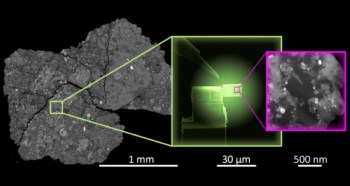
Physicists in Switzerland and the Netherlands have designed a new form of atomic force microscopy (AFM) capable of revealing the identity of individual atoms within a molecule for the first time. The result is a key breakthrough in surface microscopy and could yield important insights into chemical reactions as well as the development of single-electron devices, say the researchers.
AFM – invented some 20 years ago – gives scientists the best view for examining atoms on the surfaces of both insulators and conductors. The basic process is to scan a sharp metal tip across a sample to generate images based on the balance of tiny forces between the tip and the sample. Ongoing improvements to the technique have enabled researchers to view surfaces in unprecedented detail, including a significant breakthrough in 2007 when researchers managed to resolve isolated atoms on a material’s surface for the first time.
Focusing the issue
To improve AFM to even higher resolutions, however, researchers need to move the microscope’s tip to within 1 nm of the sample and at this range a number of technical challenges arise. The main problem is the danger of the tip being laterally displaced or even adsorbed by the sample on account of van der Waals forces – the weak electrostatic attractions between adjacent atoms or molecules that arise from fluctuations in the positions of their electrons. Moreover, as the probe edges closer to the sample, it becomes even more important to know the exact atomic composition and geometry of the AFM tip and with conventional tips this information is not always completely clear.
Now, however, a team led by Leo Gross of the IBM research laboratory in Zurich, Switzerland, has overcome these problems to resolve individual atoms and bonds within a single molecule. Gross realized that the atom or molecule at the very tip of the AFM probe governs the contrast and resolution of the microscopy. For this reason, they replaced the metal tip of conventional AFMs with a single molecule of carbon monoxide (CO), which is very stable as well as being subject to significantly smaller van der Waals forces when in close proximity to a sample.
To demonstrate their new tool the researchers applied their AFM tip to a well studied hydrocarbon known as pentacene (C22H14), which consists of five fused benzene rings and measures just 1.4 nm in length. They produced an image showing all five carbon rings as well as the individual carbon and hydrogen atoms within the molecule. The observed spacing between individual atoms was only 0.14 nm – the best resolution yet for an AFM.
Serendipitous tip
Gross revealed to physicsworld.com that there was an element of luck in discovering that carbon monoxide makes for a highly effective AFM tip because they had picked up the CO molecule by accident during routine use of their conventional AFM. The researchers were quick, however, to realize that the observed improvement in resolution made scientific sense because CO has been used in scanning tunnelling microscopy (STM), for many years, to improve resolution for the same reason.
Gross says that he and his team intend to develop their research with the short term goal of improving resolution and building up a catalogue of chemical signatures for a range of different atoms and molecules. Eventually the CO-tipped AFM could be used to determine the identity of unidentified familiar molecules for use in chemical analysis. In the longer term, new forms of AFM such as this could be applied to the study of chemical reactions and catalysis at the atomic level.
The electronics industry could also benefit from the new microscope because a better profile of molecular structure could help in the development of single electron devices. “Although we are focusing on small-scale experimental improvements, it is good to have long-term goals,” said Gross. “An improved understanding of electronic processes at the molecular scale could set the stage for electronics beyond CMOS,” he added.
This research appears in the latest edition of Science.




